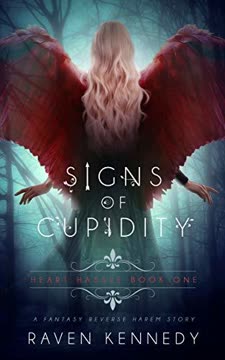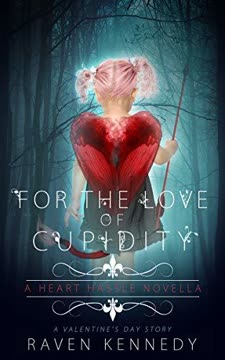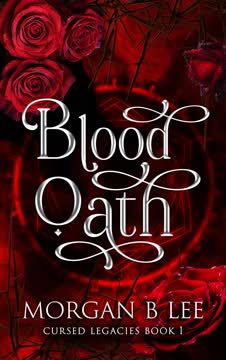Plot Summary
Stranger in Fae Land
Emelle, a newly corporeal cupid, finds herself in the fae realm, standing out with her pink hair and non-fae features. She's desperate to blend in and avoid the attention of Prince Elphar, who has placed a bounty on her head. Using her cupid powers, she manipulates crowds and seduces a pixie to get new clothes, but her efforts only highlight her outsider status. Her three genfin friends—Ronak, Evert, and Sylred—are imprisoned, and she's determined to stay close, as they are her anchors to the physical world. Emelle's humor and resilience mask her anxiety as she navigates a world where she is both a curiosity and a target.
Anchors and Imprisonment
Emelle's existence is tied to the genfins; if she strays too far, she fades and risks returning to the Veil, her incorporeal home. She attempts to infiltrate the castle to reach her friends, but is thwarted by magical barriers and vigilant guards. Her quick wit and word-vomit distract a guard, allowing her to escape, but the pain of separation intensifies. Emelle's vulnerability is palpable as she realizes her survival depends on proximity to the genfins, and she's forced to rely on the kindness of Princess Soora, who recognizes her and offers a secret meeting.
Princess's Secret Rebellion
Princess Soora, hiding her own heartbreak and political ambitions, shelters Emelle in the palace as a servant. The princess reveals her involvement in a rebellion against the monarchy, seeking Emelle's unique abilities for espionage. Emelle, torn between gratitude and suspicion, agrees to help, but her main focus remains on the imprisoned genfins. The alliance is uneasy but necessary, as both women are trapped by circumstances and secrets. Emelle's role as a spy is complicated by her fading corporeality and the growing danger within the palace walls.
Hidden Among Enemies
Emelle endures the grueling life of a servant, hiding her true nature with dyed skin and careful glamour. Duru, the princess's loyal brownie handmaiden, is both suspicious and protective, teaching Emelle the nuances of palace politics and cleaning. Emelle's attempts to reach the genfins are thwarted by magical barriers and suspicious guards. Her powers are both a blessing and a curse, as she must use them sparingly to avoid detection. The constant threat of exposure and the pain of separation from her anchors drive her to desperate measures.
Servant's Life and Schemes
Emelle's days are filled with cleaning, subterfuge, and plotting. She befriends Mossie, an earth sprite, and manipulates her way into the prison towers, only to be blocked by strict security. Her body begins to fade, a sign that time is running out. The palace is a web of intrigue, with Emelle caught between her promise to the princess and her need to save the genfins. The emotional toll of isolation and longing is softened by moments of humor and camaraderie with Duru and Mossie, but the stakes grow higher as the culling approaches.
Fading from Existence
Emelle's hand turns invisible, a terrifying reminder of her dependence on the genfins. She scrambles to maintain her disguise and seeks help from Mossie to access the prison. Her desperation is palpable as she bargains, bribes, and manipulates, but the system is stacked against her. The pain of fading is both physical and emotional, underscoring her fear of being lost forever. The princess's plan to use Emelle as a spy is complicated by Emelle's deteriorating condition, and the urgency to find a new anchor becomes critical.
Desperate for Connection
Okot, a lamassu and Princess Soora's guard, is introduced as Emelle's fated mate. Their instant, primal connection offers Emelle a new anchor and a chance at survival. Okot's acceptance of Emelle's complicated ties to the genfins is both touching and refreshing, providing her with the unconditional support she craves. The dynamic between Emelle, Okot, and the genfins becomes more complex, as jealousy, loyalty, and desire intertwine. Emelle's sense of belonging is tested as she navigates multiple bonds and the looming threat of the culling.
Culling: Trials of Survival
The culling begins, a brutal series of trials designed to break and kill the contestants. Emelle, disguised as a noble, watches in agony as the genfins fight for their lives. The games are rigged, with deadly elemental challenges and forced violence. The genfins' strength, intelligence, and unity are tested, and Emelle's emotional turmoil is heightened by her inability to intervene directly. The spectacle of violence is both a commentary on power and a crucible for the characters' relationships, as survival becomes the only goal.
Reunion and Tensions
Emelle finally reunites with the genfins, but the joy is tempered by jealousy, unresolved feelings, and the revelation of her dependence on them. The arrival of Delsheen, the genfins' former intended mate, stirs old wounds and forces the covey to confront their past. Emelle's honesty and vulnerability challenge the genfins to reevaluate their priorities and desires. The tension between loyalty to the covey and individual longing is palpable, setting the stage for a new understanding and deeper bonds.
The Royal Ball Trap
The royal ball is both a celebration and a trap, with Emelle forced into the spotlight by Prince Elphar. The prince's manipulations and Delsheen's presence threaten to unravel everything. Emelle's quick thinking and ability to feign submission save her from immediate punishment, but the danger is ever-present. The ball is a microcosm of the fae realm's cruelty and intrigue, with shifting allegiances and secrets exposed. Emelle's courage and wit are tested as she navigates the treacherous social landscape.
The Prince's Deadly Game
Prince Elphar reveals his true sadism, forcing Emelle to participate in a deadly game where her choices determine the genfins' fate. The culling's final round is a spectacle of monsters and magic, with Emelle's guilt and helplessness at the forefront. The prince's psychological warfare is devastating, and Emelle's capture and torture push her to the brink. The theme of agency versus powerlessness is explored as Emelle is stripped of control and forced to confront her own limits.
Veil, Violence, and Betrayal
Emelle is beaten and imprisoned, then fades back into the Veil, believing she has lost her anchors forever. The aftermath of the culling is chaotic, with the genfins' survival uncertain and Okot's fate unknown. Emelle's invisibility is both a curse and a shield as she searches for answers and a way back. The revelation of Princess Soora's possible betrayal and the arrest of innocents deepen the sense of danger and mistrust. Emelle's resilience is tested as she grapples with guilt, loss, and the need for justice.
The Horned Hook's Bargain
The genfins seek out the Horned Hook, a notorious thief, to find a way to restore Emelle's corporeal form and locate Okot. The journey is fraught with danger, but also moments of levity and camaraderie. The Horned Hook's enigmatic nature and connection to Emelle add intrigue, while the chameleen twins' magic offers a solution. The process of regaining her body is painful and transformative, marking a turning point in Emelle's journey. The rescue of Okot and the deepening of bonds with the genfins set the stage for new beginnings.
Mating, Markings, and Change
Emelle and Okot confirm their mate bond in a romantic, flower-filled setting, marking each other in unique ways. The genfins and Emelle perform their own mating ceremony, solidifying their covey and embracing their unconventional family. Emelle's powers begin to change, with new feathers and eye colors appearing, and her abilities becoming unpredictable. The theme of transformation—physical, emotional, and magical—underscores the acceptance of difference and the forging of new identities.
Assault on the Den
The genfins' den is attacked by soldiers wearing Princess Soora's colors, casting doubt on old alliances. Emelle's powers manifest in unexpected and deadly ways as she defends her covey, killing for the first time and grappling with the consequences. The aftermath is one of shock, guilt, and the need to flee. The sense of safety is shattered, and the group is forced into hiding, questioning who they can trust and what their next move should be.
Aftermath and Unraveling
Emelle struggles with the trauma of killing and the fear of her changing powers. The genfins offer comfort and reassurance, but the threat of betrayal and the loss of their home weigh heavily. The group's unity is tested as they debate their next steps, with Evert's anger and Ronak's pragmatism clashing. Emelle's determination to uncover the truth and protect her family drives her to take risks, even as the cost of survival grows higher.
Spy Mission and Sacrifice
Emelle volunteers to spy on Princess Soora, despite the dangers and the genfins' objections. The mission is a test of her courage, resourcefulness, and loyalty. The emotional stakes are high, with the possibility of betrayal, the need to find Okot, and the risk of losing herself again. The theme of sacrifice—of safety, trust, and self—is central, as Emelle chooses to act for the greater good, even at personal cost.
Cupid in Trouble
As Emelle sets out on her mission, she is abruptly yanked back to Cupidville, summoned by her superiors for breaking the rules. The abrupt ending leaves her fate—and the fate of her covey and allies—uncertain. The emotional arc comes full circle, with Emelle once again caught between worlds, her agency and identity in question. The story closes on a note of suspense, with the promise of new challenges and the hope of reunion.
Characters
Emelle
Emelle is a cupid who has recently become corporeal after decades in the Veil. Her humor and self-deprecation mask deep loneliness and a desperate need for connection. She is fiercely loyal to her friends, especially the genfins who serve as her anchors to the physical world. Emelle's powers are both a gift and a curse, making her a target and an asset in the fae realm. Her journey is one of self-discovery, as she navigates love, loss, and the complexities of belonging. Emelle's psychological arc is defined by her struggle with agency, her fear of abandonment, and her evolving sense of self as she forms bonds with multiple mates and confronts her own power.
Ronak
Ronak is the covey's alpha, burdened by past betrayals and the weight of leadership. His initial hostility toward Emelle masks deep-seated fears of vulnerability and failure, stemming from his disastrous relationship with Delsheen. Ronak's journey is one of learning to trust and accept love, both from his covey and from Emelle. His transformation—marked by the emergence of cupid wings—symbolizes his acceptance of change and the breaking of old patterns. Ronak's protective instincts are both his strength and his weakness, driving him to fierce loyalty but also to moments of rigidity and control.
Evert
Evert is the covey's wild card, quick to anger and quicker to love. His brashness and humor hide a deep fear of abandonment and a longing for acceptance. Evert's relationship with Emelle is marked by playful banter, sexual tension, and genuine affection. He is the first to openly choose Emelle, challenging the covey's traditions and pushing for change. Evert's psychological arc is one of embracing vulnerability and redefining loyalty, as he learns to balance his desires with the needs of the group.
Sylred
Sylred is the covey's emotional anchor, mediating conflicts and offering comfort. His sound-based magic reflects his role as a harmonizer, both literally and figuratively. Sylred's kindness and patience are matched by a quiet strength, and he is often the first to support Emelle's choices. His willingness to sacrifice for the covey and his mate underscores his deep sense of responsibility. Sylred's psychological journey is one of balancing selflessness with self-assertion, as he navigates the shifting dynamics of the group.
Okot
Okot is a lamassu whose instant, primal connection with Emelle offers her a new anchor and a sense of unconditional acceptance. His physical strength is matched by emotional sensitivity, and he is unafraid to express devotion and vulnerability. Okot's willingness to share Emelle with the genfins reflects his confidence and security in their bond. His journey is one of integration, as he becomes part of the covey and supports Emelle's quest for belonging and agency.
Princess Soora
Princess Soora is a high fae trapped in a loveless marriage and a web of political intrigue. Her involvement in the rebellion is driven by both personal heartbreak and a desire for justice. Soora's relationship with Emelle is complex, marked by mutual need, suspicion, and moments of genuine connection. Her willingness to risk everything for change is both admirable and dangerous, and her true loyalties remain ambiguous. Soora's psychological arc is defined by her struggle between duty and desire, and her role as both ally and potential betrayer.
Duru
Duru is Princess Soora's brownie handmaiden, whose suspicion of Emelle gradually gives way to reluctant respect. Her obsession with cleanliness and order reflects a need for control in a chaotic world. Duru's loyalty to the princess is unwavering, and she serves as both a gatekeeper and a guide for Emelle. Her bluntness and practicality provide comic relief and grounding, and her willingness to help in times of crisis underscores her hidden warmth.
Prince Elphar
Prince Elphar is the embodiment of fae cruelty and caprice. His charm masks a deep-seated need for control and domination, and his games are designed to break spirits and assert supremacy. Elphar's obsession with Emelle is both personal and political, as he seeks to punish her for defiance and use her as a pawn. His psychological arc is one of escalating sadism and paranoia, driving the story's central conflicts and forcing the protagonists to confront their own limits.
The Horned Hook (Belren)
The Horned Hook is a master of secrets and bargains, whose motivations are as mysterious as his powers. His connection to Emelle adds layers of intrigue, and his willingness to help is always tinged with self-interest. Belren's telekinetic abilities and network of contacts make him a valuable ally, but his loyalty is never guaranteed. His psychological arc is one of self-preservation and curiosity, as he navigates the shifting allegiances of the fae realm.
Delsheen
Delsheen is the genfins' former intended mate, whose betrayal sets the story in motion. Her beauty and ambition mask deep insecurities and a willingness to use others for her own gain. Delsheen's presence forces the covey to confront their past and redefine their future, serving as both a foil and a warning. Her psychological arc is one of self-destruction and missed opportunities, highlighting the dangers of pride and the cost of betrayal.
Plot Devices
Anchoring and Fading
Emelle's corporeality is anchored to the genfins, making her survival dependent on proximity and connection. This device externalizes her emotional needs, turning longing and belonging into literal life-or-death stakes. The threat of fading adds urgency to her actions and heightens the tension in every separation, while also serving as a metaphor for the fear of abandonment and the search for identity.
Reverse Harem and Polyamory
The story employs the reverse harem trope, with Emelle forming romantic and sexual bonds with multiple partners. This structure allows for the exploration of jealousy, loyalty, and the redefinition of family and love. The covey's dynamics are a microcosm of chosen family, with each character bringing unique strengths and vulnerabilities. The polyamorous relationships challenge traditional notions of exclusivity and highlight the importance of communication and consent.
Magical Trials and Culling
The culling serves as both a plot engine and a crucible for character development. The trials are designed to break spirits and force alliances, with each round escalating the stakes and revealing hidden strengths and weaknesses. The spectacle of violence is a commentary on power and cruelty, while the genfins' survival is a testament to unity and resilience. The culling also provides opportunities for foreshadowing, as the prince's manipulations and the contestants' ingenuity hint at larger conflicts to come.
Disguise, Espionage, and Betrayal
Emelle's need to disguise herself and act as a spy drives much of the narrative tension. The constant threat of exposure, the ambiguity of allies, and the ever-present possibility of betrayal create a sense of paranoia and suspense. The use of glamour, dye, and subterfuge reflects the story's themes of identity and transformation, while the shifting allegiances force characters to confront their own values and loyalties.
Transformation and Marking
Emelle's changing powers, new feathers, and the marking of her mates serve as both plot devices and symbols of transformation. These changes externalize the internal shifts in identity, loyalty, and love, marking the characters as part of a new, unconventional family. The unpredictability of Emelle's powers adds both danger and possibility, foreshadowing future challenges and growth.
Foreshadowing and Cliffhangers
The narrative structure employs foreshadowing through Emelle's fading, the prince's games, and the hints of larger political machinations. The use of cliffhangers—most notably the abrupt return to Cupidville—ensures that the story's resolution is always just out of reach, maintaining tension and reader investment. The interplay of hope and uncertainty is central to the emotional arc, leaving characters and readers alike yearning for answers.
Analysis
Bonds of Cupidity is a witty, emotionally charged exploration of belonging, love, and transformation set against the backdrop of a cruel and capricious fae realm. At its heart, the novel is about the search for connection in a world that punishes difference and vulnerability. Emelle's journey—from lonely, invisible cupid to the center of a fiercely loyal, unconventional family—mirrors the universal longing for acceptance and agency. The reverse harem structure challenges traditional notions of love and loyalty, celebrating polyamory and chosen family as sources of strength. The story's humor and irreverence balance its darker themes of trauma, betrayal, and power, while the magical trials and shifting allegiances keep the stakes high. Ultimately, Bonds of Cupidity is a celebration of resilience, self-discovery, and the courage to claim one's place in a world that insists on keeping outsiders at the margins. The novel's cliffhanger ending underscores the ongoing struggle for agency and belonging, promising further growth, danger, and transformation in the chapters to come.
Last updated:
Review Summary
Bonds of Cupidity receives mixed reviews, with most readers enjoying the humor, romance, and character development. Many praise Emelle's witty narration and the expanding relationships. Some dislike the addition of a new love interest or find the plot scattered. The cliffhanger ending leaves readers eager for the next book. While some criticize the writing or character depth, others appreciate the lighthearted, fun nature of the story. Overall, it's seen as an entertaining paranormal reverse harem romance with both passionate fans and detractors.



















